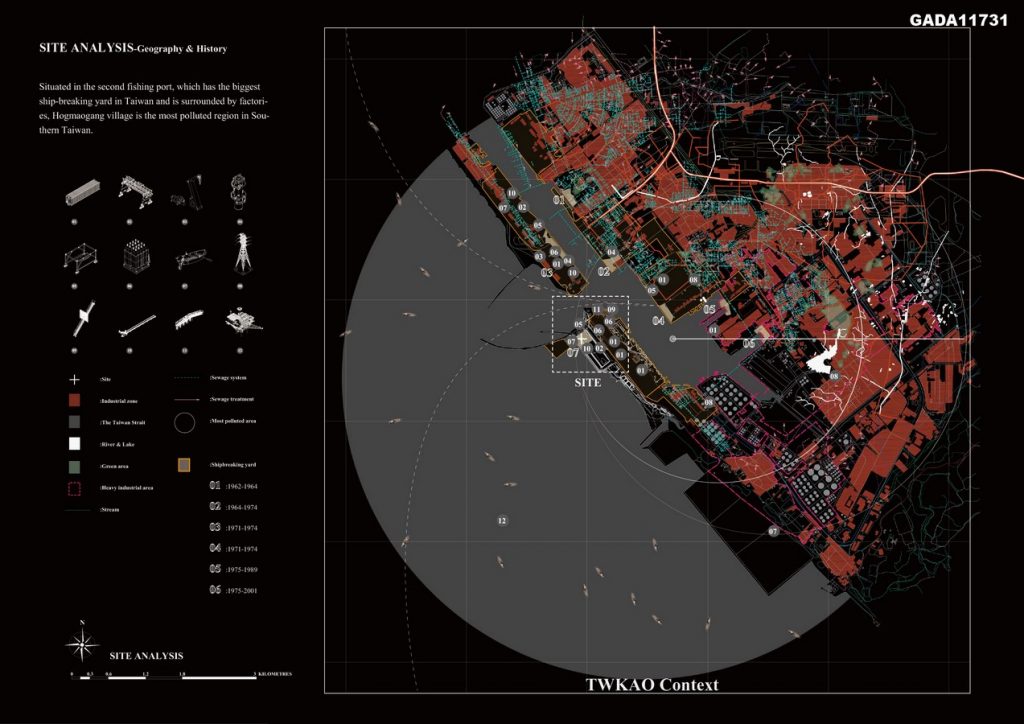The Last Green Fortress, a visionary regeneration project, is in reaction to recent pressures facing a Hogmaogang village, specifically focusing on the ongoing threat of the environmental and pressing issues regarding the welfare of the area. The scheme addresses aggravating airborne pollution caused by the ship-breaking industry adjacent to the village, which has been the major issue since the 1970s, by revolutionising the typology of the ship-breaking yard with the pioneering use of local algae cultivation technology while re-developing communal identities for Hogmaogang inhabitants at the same time.
Global Architecture & Design Awards 2018
First Award | Category: Landscape Design (Concept)
Team Members: Meng-Hsuan Yang, Tzu-Jung Huang
Country: Taiwan
 Surrounded by the sea, marine transport has been well-developed in the Hogmaogang village since the 1960s, contributing to various related industries such as ship-breaking industry, which was the main source of income for the residents. Immersing themselves in the ship-breaking yard every day, the residents had a deep attachment to this region before it became an uninhabitable place owing to progressively severe air quality, resulting in various respiratory diseases.
Surrounded by the sea, marine transport has been well-developed in the Hogmaogang village since the 1960s, contributing to various related industries such as ship-breaking industry, which was the main source of income for the residents. Immersing themselves in the ship-breaking yard every day, the residents had a deep attachment to this region before it became an uninhabitable place owing to progressively severe air quality, resulting in various respiratory diseases.
 The Last Green Fortress researches into applicable mechanics, biomimetic mechanisms and algae technology for a sustainable strategy, removing the stigma of the ship-breaking industry and benefiting the village to flourish anew. Based on studies and experiments conducted by a local algae lab, spirulina, an endemic species, plays an absolutely vital part in generating electricity and absorbing toxic substances. By utilising digital tools to manipulate the parameters of heat, wind and human activities, the proposal devises ideal spaces for working and algae cultivation including termite cave-like structures that accelerates the contaminated fume produced by the ship-breaking industry being pumped into spirulina-bioreactors.
The Last Green Fortress researches into applicable mechanics, biomimetic mechanisms and algae technology for a sustainable strategy, removing the stigma of the ship-breaking industry and benefiting the village to flourish anew. Based on studies and experiments conducted by a local algae lab, spirulina, an endemic species, plays an absolutely vital part in generating electricity and absorbing toxic substances. By utilising digital tools to manipulate the parameters of heat, wind and human activities, the proposal devises ideal spaces for working and algae cultivation including termite cave-like structures that accelerates the contaminated fume produced by the ship-breaking industry being pumped into spirulina-bioreactors.
 The protein harvested from spirulina is then used for biomass electricity generation which is stored and used as part of the regeneration of the surrounding areas, whereas, the precious metal separated from spirulina can be a new source of decent income for the residents.
The protein harvested from spirulina is then used for biomass electricity generation which is stored and used as part of the regeneration of the surrounding areas, whereas, the precious metal separated from spirulina can be a new source of decent income for the residents.
After several years, the ship-breaking tower and the infrastructural components would be a place where the locals are able to work in a sustainable economic network, bringing people together again.
 The Last Green Fortress proposes an environment responsive structure which involves biological reactions and biomimetics, bettering the quality of life and the workplace environment, as well as preserving the cultural landscape.
The Last Green Fortress proposes an environment responsive structure which involves biological reactions and biomimetics, bettering the quality of life and the workplace environment, as well as preserving the cultural landscape.
If you’ve missed participating in this award, don’t worry. RTF’s next series of Awards for Excellence in Architecture & Design – is open for Registration.
Click Here








